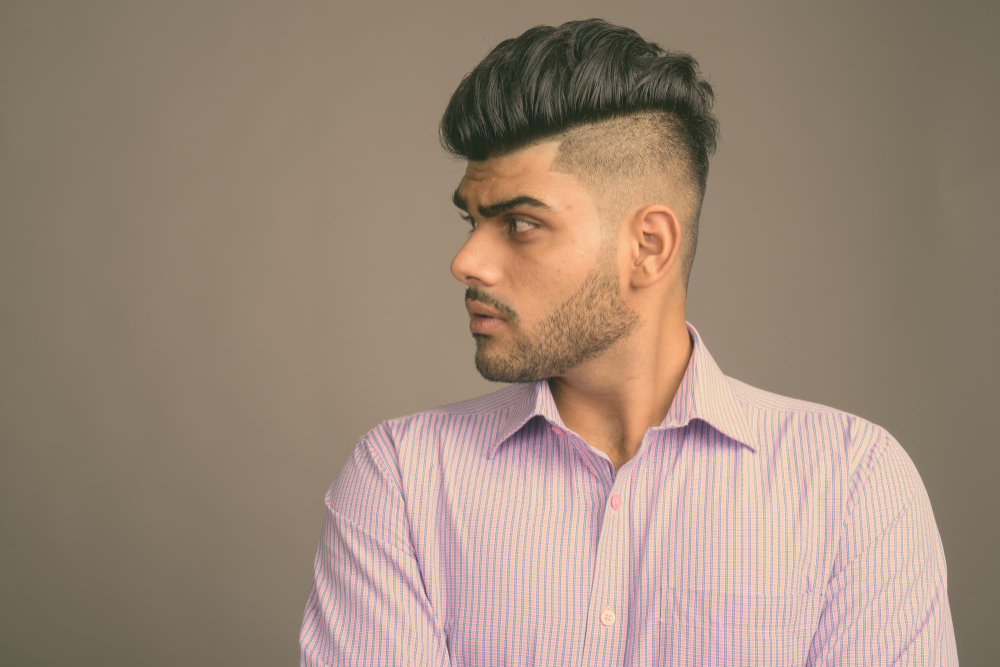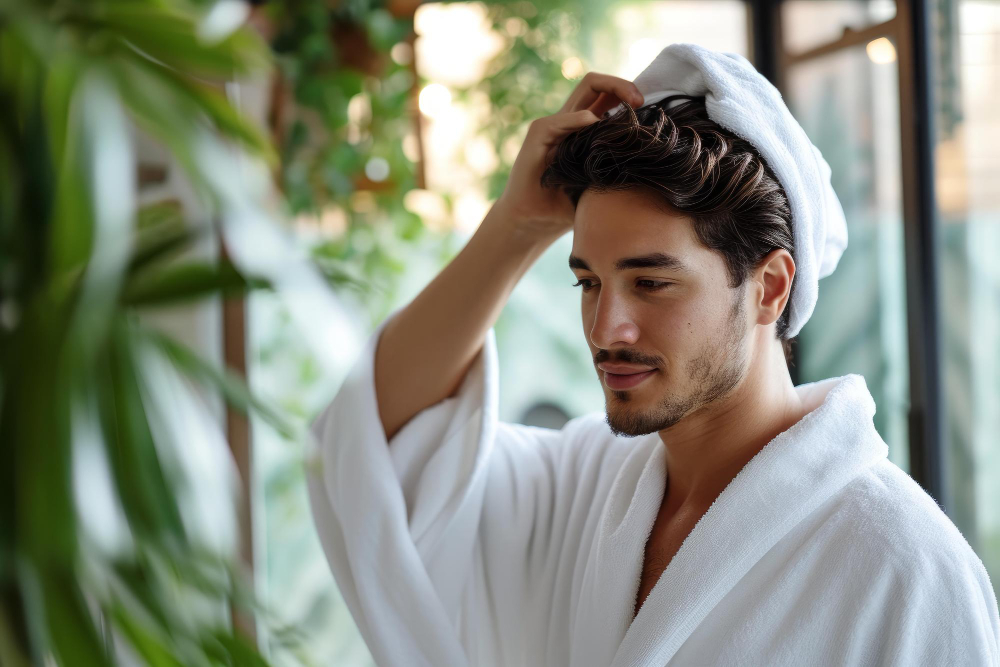Different Hair Types For Men: The Ultimate Guide

Understanding the differences in hair types is not just about aesthetics for men; it’s about embracing and managing your natural hair with confidence and style. This guide will cover different types of hair, including straight, wavy, curly, and coily. Whether it’s curly, wavy, or coily, each type of hair requires specific care and styling methods to look its best. This comprehensive guide will walk you through the various hair types from Type 1 to Type 4c, unravel the science behind them, and offer practical tips for styling and care. Let’s embark on a journey to discover the unique characteristics of your hair and how to make the most of what nature gifted you.
What Does Hair Type Mean for Men?
Exploring the Science Behind Hair Typing
The concept of hair typing is rooted in the science of the hair strand, hair shaft, hair follicle shape, and the curl pattern of an individual’s hair. A person’s hair type is determined by the shape of the hair follicle and how the hair strands grow from the scalp. Straight hair types have round follicles, while curly and coily types tend to have more oval or asymmetrical follicles. Hair porosity, which refers to the hair’s ability to absorb and retain moisture, also plays a crucial role in hair care. Understanding the science behind your hair type can lead to better hair care practices and styling techniques, ultimately improving your hair health over time.
Decoding the Chart: From Type 1 to Type 4c
The hair type chart categorizes hair into four main types: Type 1 for straight hair, Type 2 for wavy hair, Type 3 for curly hair, and Type 4 for coily or afro-textured hair. Within these categories, there are subtypes (e.g., 2c, 3b, 4a) that further define the curl pattern, hair density, and strand thickness. Type 2 hair can range from loose waves to defined curls. Identifying whether your hair is, for instance, type 2c with strands that are prone to frizz, or type 4c with tight coils that are prone to dryness, can significantly influence how you care for and style your hair. Type 3 hair includes various curl patterns, such as loose curls and bouncy curls.
How Knowing Your Hair Type Can Transform Your Style
Recognizing your specific hair type and its subtypes unlocks the door to optimized care and styling. For men, this means using the right hair products, from shampoos and conditioners to styling agents, designed for your hair’s unique needs. You’ll avoid common hair care mistakes, such as over-washing type 4 hair or under-moisturizing type 2 hair, and embrace techniques that enhance your natural curl pattern, volume, and hair health.
Additionally, minimizing the use of heat styling tools is crucial to prevent damage and maintain the health and luster of your hair.

From Straight to Coily: Navigating Through Four Types of Hair
The Essentials of Hair Type 1 and Straight Hair Care
Type 1 hair, or straight hair, is characterized by its sleek and oily nature. Daily or frequent washing might be necessary to prevent the oily look, but choosing the right type of shampoo — preferably one that doesn’t strip natural oils — is crucial. For men with straight hair, lightweight conditioners and occasional use of hair oils can maintain the hair’s natural shine without weighing it down.
Wavy Hair – Type 2 Hair
Type 2 hair, or wavy hair, walks the line between straight and curly, offering versatility in styling. Embracing the natural waves involves using hair products that enhance the curl pattern without causing frizz. Hydrating shampoos and conditioners, along with mousse or lightweight styling creams, can help manage and define wavy hair, making your morning routine both efficient and effective.

Curly Hair (Type 3) vs. Coily Hair (Type 4)
The defining feature of curly (Type 3) and coily (Type 4) hair types is the tightness of their curl patterns. Kinky hair, which falls under the coily hair spectrum, is characterized by tight, springy curls that require ample moisture to maintain definition and prevent breakage, frizz, and tangling. These hair types often struggle with moisture retention and are prone to dryness and hair damage. Deep conditioning treatments, heavier cremes, and oils are often necessary to maintain hair health. Protective styles can also prevent hair damage and promote growth. Understanding the specific needs of your curly or coily hair will help in choosing the right products and styles that highlight the natural beauty of your hair texture.

Curly, Wavy, or Coily: How to Find Your True Hair Type
Visual Guide and Chart for Identifying Your Hair Type
Identifying your hair type is the first step in understanding how to properly care for and style your hair. Visual guides and detailed charts that take into account curl patterns, strand width, and overall hair density offer a comprehensive overview to help you pinpoint your hair type. These resources often include comparisons and images that provide a visual frame of reference, from the subtle waves of 2a hair to the tight coils of 4c hair.
Why Knowing Your Subtype (e.g., 2c, 3b, 4a) Matters
While general hair types provide a broad understanding, the subtypes offer a more nuanced view that can further refine how you approach hair care and styling. Each subtype has distinct characteristics — for instance, 3c curls are tighter and thicker than 3b curls, which means they may require different products or routines to maintain optimal health and appearance. Knowing your subtype allows for a personalized hair care plan that targets your specific needs.
Common Misconceptions and Mistakes in Hair Typing
One common mistake in hair typing is assuming that a person’s hair falls into a single category. Many men find that their hair exhibits characteristics from different types or subtypes, leading to a mixed hair type that may require a combination of care and styling techniques. Moreover, hair texture can change over time due to factors like hair damage, diet, or aging, making it important to periodically reassess your hair type and adapt your hair care regimen accordingly.

Managing and Styling Hair: Tips for Every Hair Type
Daily Routines for Healthy Hair: Type 1 to Type 4
A daily hair care routine tailored to your hair type can vastly improve its health and appearance. For type 1 hair, limiting washes and using light products can prevent oil buildup. Type 2 and 3 hair types benefit from regular hydration and the use of defining products. Meanwhile, type 4 hair demands deep conditioning treatments and protective styling to thrive. Remember, regardless of your hair type, minimizing heat styling and chemical treatments can prevent unnecessary damage.
Choosing the Right Products: From Shampoos to Conditioners
Selecting the right hair products is crucial for maintaining healthy hair. Look for shampoos, conditioners, and styling products that cater to your specific hair type’s needs. For example, sulfate-free shampoos are ideal for curly and coily hair types to prevent dryness, while volumizing products are better suited for those with straight or fine hair. Reading product labels and understanding the ingredients can help you make informed decisions about what to use on your hair.

Styling Tips: Making the Most of Your Natural Hair Type
Styling your hair should enhance its natural texture and health. Men with straight hair may opt for minimal styling products to maintain hair’s natural movement. For those with wavy or curly hair, products that define curls and control frizz, such as curl creams or sea salt sprays, can highlight your hair’s natural beauty. Coily hair types might find that twists or braids not only protect their hair but also offer a versatile look. Experiment with different styles and products to discover what works best for your hair.
Dealing with Hair Challenges: Hair Loss to Dryness Across Hair Types
Preventing and Addressing Hair Loss for All Hair Types
Hair loss is a common concern for men across all hair types. Factors such as genetics, stress, and improper hair care can contribute to thinning hair. Using gentle, fortifying shampoos, avoiding tight hairstyles that pull on the hair, and incorporating scalp massages into your routine can promote hair health and minimize hair loss. In some cases, consulting with a dermatologist may provide additional insight and treatment options.
Combating Dryness: Special Care for Curly and Coily Types
Curly and coily hair types are especially prone to dryness due to their structure, which hampers the scalp’s natural oils from coating the entire hair strand. Intensive hydrating treatments, such as weekly deep conditioning sessions and the use of leave-in conditioners, can help lock in moisture. Additionally, sealing hair with light oils after washing can maintain hydration and protect against environmental damage.
Treating Oily Hair Without Stripping Natural Oils
On the opposite end of the spectrum, men with oily hair may struggle with maintaining a fresh look without over-washing, which can strip hair of its natural oils and lead to increased oil production. Balancing wash frequency and using clarifying shampoos sparingly can help manage oiliness. Lightweight, water-based styling products will keep hair looking styled without adding to the greasiness.
The journey to understanding and embracing your hair type involves recognizing the unique characteristics of your hair, learning the best care practices, and experimenting with styles that celebrate your natural texture. With the right knowledge and tools, every man can achieve healthy, stylish hair that reflects his individuality and confidence.

You might like these!



